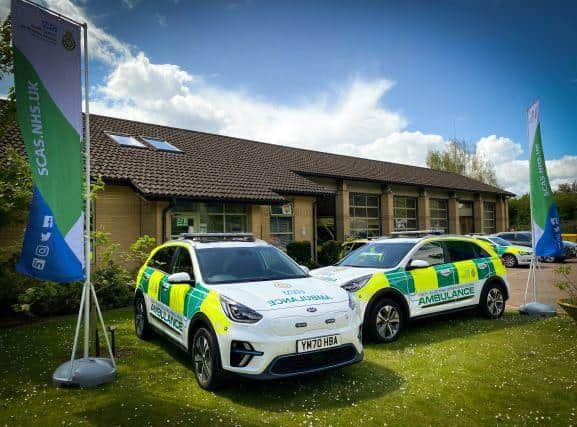First fully electric vehicles launched by ambulance service that covers Milton Keynes
and live on Freeview channel 276
South Central Ambulance Service (SCAS) now have two fully electrical vehicles within its fleet.
The new response vehicles will be active in the region shortly an SCAS director revealed today (May 19).
Advertisement
Advertisement
These vehicles will be used by first responder paramedics in emergency situations and will carry the equipment, medication and supplies needed for these desperate scenarios.


Both cars are adapted Kia e-Niros that have been rejigged to better suit emergency service staff.
Charles Porter, director of finance at SCAS, said: “I am delighted that these first two fully electric, zero emission emergency response vehicles will shortly be introduced to our operational fleet. I would like to thank everyone in the project team for their determination and commitment to delivering this significant step in our strategy to continually reduce our environmental impact."
Sustainability and lowering carbon emissions has been a point of emphasis across Milton Keynes in recent years. In 2019 Milton Keynes Council officials revealed a plan to make the entire borough carbon neutral by 2030 and negative by 2050.
Advertisement
Advertisement
Mr Porter further revealed the efforts of SCAS to play its part in protecting the environment, adding: "As an organisation, we operate over 1,300 vehicles to deliver our services so being able to move to fully electric vehicles will be vital in order to deliver our environmental goals.


"We are key partners in national projects to deliver zero emission emergency vehicle fleets and we are already exploring how we can bring electric vehicles into our emergency ambulance and patient transport service operations.”
According to a SCAS spokesperson it was an 18-month search process to find the right vehicle and manufacturer for this project. Due to a limited pool of manufacturers to pick from and the need to find a vehicle suitable for emergency responses.
However, even since initial trials in 2019, SCAS reveals that with a greater number of vehicles available for testing, combined with further advances in electric motoring technology, it became clear that this service could now be delivered.
Advertisement
Advertisement
Nick Lambert, head of education – driving at SCAS, further outlined how the search process worked, saying: “We tested quite a few electric vehicles and the Kia eNiro came out on top every time as an all-round, versatile option for what we were looking for in our emergency response vehicles.
"Our staff will require extra training before taking the Kia eNiro out on the road. Electric vehicles perform slightly differently from traditional vehicles. We’ll need to train staff in how much more responsive they are in terms of acceleration and how to drive using regenerative braking which allows us to regain energy whilst the vehicle is moving to extend its range.”
Another factor the SCAS outlines in choosing the Kia eNiro was the 282-mile driving range on a single charge. Emergency response vehicles are expected to cover 90-100 miles in an average 10-hour operational shift. Charging points are available at the Trust’s ambulance stations, as well as local hospitals.
Gregory Edwards, vehicle commissioning unit manager, South Central Fleet Services, explained the process of adapting the vehicles in more detail, stating: “It was really exciting for my team and I to be given the opportunity to design the vehicles from the ground up, taking them from a standard electric road vehicle to an emergency response vehicle.
Advertisement
Advertisement
"There were a number of challenges we had to overcome, including ensuring the additional electric systems needed in an emergency vehicle wouldn’t drain the battery, emergency light fittings, weight and space limitations, but we’re really pleased with the end result and our operational colleagues can’t wait to get behind the wheel and take them out to help our patients.”
The Ambulance Service is claiming it will also save significant costs, by using electric vehicles. Highlighting there is no internal combustion engine in the vehicle, there is a significant reduction in moving parts required, no oil or filter changes needed, less waste produced, reduced downtime for the vehicles to be off road and an estimated 25% reduction in overall maintenance costs compared to a petrol or diesel vehicle.
The UK Government’s road to zero strategy is a commitment for all new cars and vans to be effectively zero emission by 2040. The introduction of the first two electric emergency response vehicles into the SCAS emergency fleet reflects the Trust’s own Green Strategy which aims to deliver a 50% reduction in CO2 emissions by 2030.
These first two electric vehicles will be based at the Trust’s Oxford City resource centre as part of an initial pilot study.The hope is if the vehicles operate efficiently that electric vehicles will be operational in all regions SCAS covers including Milton Keynes.